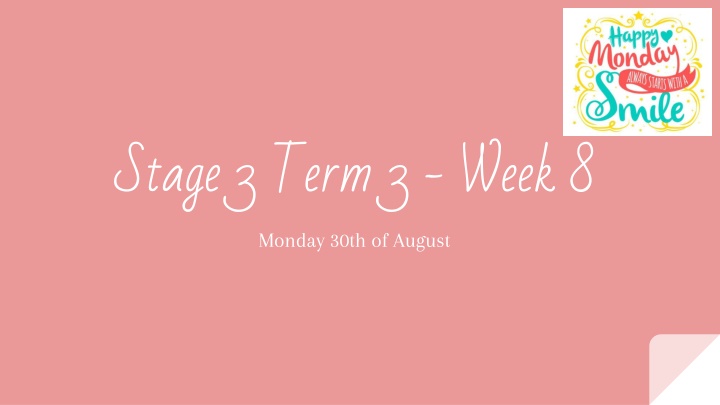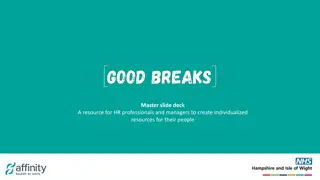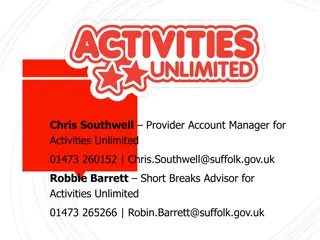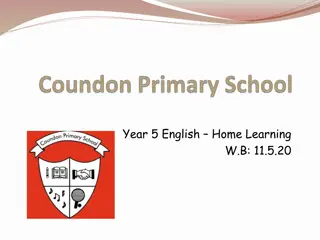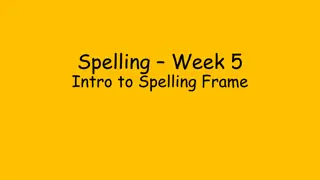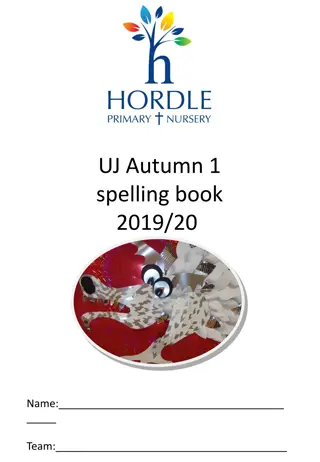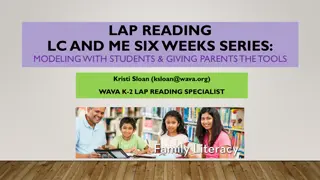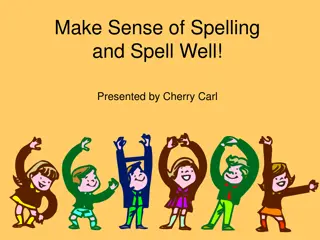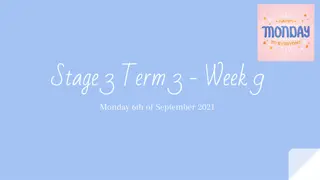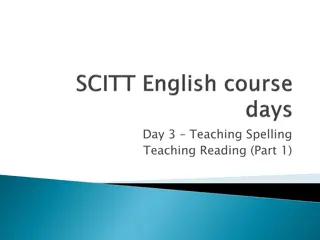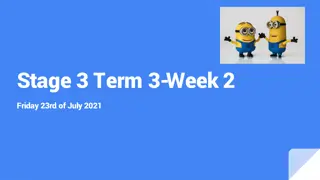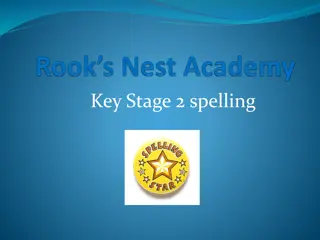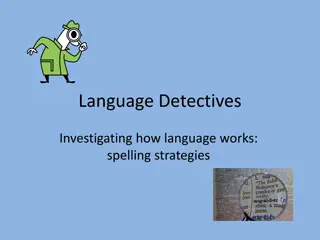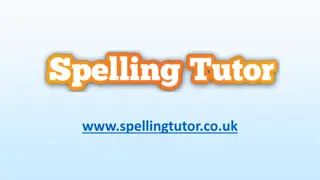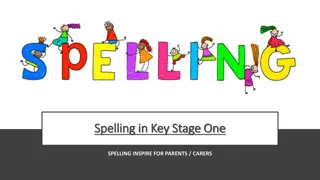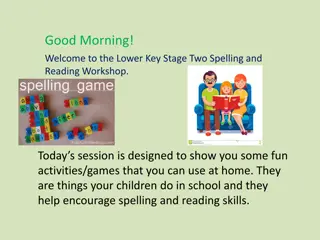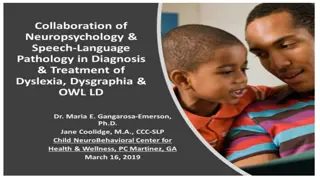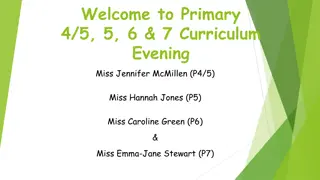Engaging Learning Activities for Week 8 Including Spelling, Reading, and Brain Breaks
Dive into a productive Week 8 with spelling practice, reading comprehension tasks, and refreshing brain breaks. Explore phonics concepts, sounding out strategies, and informative text features to enhance language skills. Engage in fruit breaks and outdoor resets for a well-rounded learning experience.
Download Presentation

Please find below an Image/Link to download the presentation.
The content on the website is provided AS IS for your information and personal use only. It may not be sold, licensed, or shared on other websites without obtaining consent from the author.If you encounter any issues during the download, it is possible that the publisher has removed the file from their server.
You are allowed to download the files provided on this website for personal or commercial use, subject to the condition that they are used lawfully. All files are the property of their respective owners.
The content on the website is provided AS IS for your information and personal use only. It may not be sold, licensed, or shared on other websites without obtaining consent from the author.
E N D
Presentation Transcript
Stage 3 Term 3 - Week 8 Monday 30th of August
Week 8 Spelling Lists Look Cover Write check your spelling words in your book. Record your list words using red for the consonants and blue for the vowels. Then complete an activity from the spelling choice board.
primary flew swing juice often October Week 8 Words octuplet unnecessary soften screw bruising lung octave softening anniversary recruitment brew wing octagonal oftentimes complimentary octane bruit eschew spring softener boundary octopod spruik threw softness octahedral along bruise revolutionary gu (as in guitar) or silent u octopus drew cruise sanctuary or as in horse Phonic Concept: primus (meaning: first) Sounding Out Strategy: syllabic spelling dge (as in bridge) [dge=/j/] ow (as in owl) vague beneficiary porch rowdy bridge prime -ory (meaning: relating to) beguile shorn sledge clown primitive history guilty torch porridge primate predatory coward guest inventory budge primeval forty powder disguise category primer crudge guarantee scowl thorn accessory primacy edge baguette gown territory primrose nudge guinea observatory primarily laboratory
Spelling (20 minutes) - Look Cover Say Write Check your words. Complete an activity from the Spelling Choice Board.
Fruit Break/ Brain Break: Grab a piece of fruit or have a 10 minute break to go outside reset, refresh and restart.
Read works and Read Theory Complete the reading passage and comprehension questions that have been provided by your class teacher in the google classroom. This should take you 40-45 minutes to complete.
LANGUAGE FEATURES OF INFORMATIVE TEXTS Subject Specific- Technical Vocabulary Nouns Groups - descriptive language, adjectives, comparative language Eg. fireworks, celebrate, festival, holiday, beginning, midnight Proper Nouns for the beginning of Names of people, places and special days. Eg. brightest colours, loudest bangs, largest crowds All around the world the largest All around the world the largest crowds gather to celebrate New crowds gather to celebrate New Year s Eve. In cities including Paris, Year s Eve. In cities including Paris, Sydney and London you will see the Sydney and London you will see the brightest firework displays at brightest firework displays at midnight. midnight. Eg. New Year s Eve, Paris, Sydney, London
The Great Barrier Reef The Great Barrier Reef is the world s largest coral reef. It is one of the most complex natural ecosystems on the planet. The Great Barrier Reef is close to the coast of Queensland, Australia. It consists of nearly 3000 coral reefs and over 900 islands. The Great Barrier Reef is home to 14 000 different plant and animal species including many that are endangered.Some of these organisms include whales, sea turtles, birds and coral. Because of this, the reef is a popular tourist destination. Over two million people visit the reef every year. The Great Barrier Reef Read the information text, Read the information text, identify and list the following identify and list the following (See Slide 7 for examples) (See Slide 7 for examples) Subject specific Subject specific technical vocabulary technical vocabulary Noun groups; descriptive Noun groups; descriptive and comparative words and comparative words Proper Nouns Proper Nouns (Hint: They must start with a (Hint: They must start with a capital letter!) capital letter!)
LANGUAGE FEATURES ANSWERS LANGUAGE FEATURES ANSWERS Subject specific Subject specific technical vocabulary technical vocabulary Coral reef Coral reef Ecosystem Ecosystem Species Species Endangered Endangered Tourist destination Tourist destination Noun groups; Noun groups; descriptive and descriptive and comparative words comparative words Largest Largest Most complex Most complex Natural ecosystem Natural ecosystem Popular tourist destination Popular tourist destination 14000 different plants and animals species 14000 different plants and animals species Over two million people Over two million people Proper Nouns Proper Nouns Great Barrier Reef Great Barrier Reef Queensland, Australia Queensland, Australia
Learning Support If you are working with Ms Carrington, Mrs Waggie or Mrs McCormick in Term 3, you will find your work in the Learning Support Google Classroom. Everyone else, please go to the next slide.
EPIC EDITING Rewrite the passage making the corrections required. 6 Capital Letters 2 full stops 1 wrong word use 1 spelling mistake Too much? Just do 1 paragraph. Challenge yourself- Try the whole passage!
We will continue to examine informative writing this week. Let s look at Procedures. First of all, the purpose of a procedure is to provide instructions about how to achieve a goal by following a series of steps. When we write instructions, we need to ensure that they are clear, specific and simple to understand. Examples: - A recipe - Directions like Google Maps - An instruction manual for furniture - How To guide - Rule book for a game Procedures use: Present tense Action verbs or commands Adverbs Subject-specific vocabulary Short, clear sentences
Think about the language used in this example
Lets try a simple example. Match the instructions to the pictures below.
Use the instructions from the previous slide to write a full recipe make Fairy Bread. Bonus: Make fairy bread as a snack with mum or dad s help. write a full recipe on how to Click on this link when you re finished writing your version and check if it is similar. Fairy Bread Recipe - Australian Food Or check below
P PUBLIC SPEAKING SKILL BUILDING UBLIC SPEAKING SKILL BUILDING CLICK HERE TO WATCH A CLIP ABOUT MATTER CLICK HERE TO WATCH A CLIP ABOUT MATTER Matter is what you say in your speech. It's the words, stories, ideas and examples you use to explain your topic to the audience. Matter matters the most! Each speech should have a purpose (or goal). Matter is what you say in your speech. It's the words, stories, ideas and examples you use to explain your topic to the audience. Matter matters the most! Each speech should have a purpose (or goal).
Handwriting/ Typing : As part of the curriculum we need to learn how to effectively type and use digital technologies. Google Typing Club and take their placement test then complete one or more of the lessons. This should take 20 -30 minutes.
Lunch break-Break 1 Enjoy the 30 minute lunch break with your family. Try to eat something healthy and drink some water.
Middle Session Mathematics; Numeracy Ninjas Week 8 Session 1
Numeracy Ninjas You have 5-10 minutes to complete the questions. Numeracy Ninjas Week 18 Session 1
Numeracy Ninjas ANSWERS Mental Strategies Times Tables Key Skills Numeracy Ninjas Week 18 Session 1
Mathematics - Division; Quotient I am learning to: Solve problems involving division by a one-digit number. - use the term 'quotient' to describe the result of a division calculation. What is a Quotient? The quotient is the answer to a division question/problem. For example; 'The quotient when 30 is divided by 6 is 5' View the video below right for further explanation of what the quotient is. Arithmetic: What is a Quotient? (Division) Division has its own vocabulary! It seems like a lot of new words to learn, but it really does make division problems easier to talk about. In this video, we'll discuss how when you divide two numbers, you get a "quotient" and a "remainder." About this series: Every Thursday, we're going to Math Camp! This year, we're learning about ARITHMETIC. We'll learn how to add, subtract, multiply, and divide. We'll also learn about whole numbers (integers), fractions, decimals, and complex numbers. These are topics that first come up in arithmetic, but will continue to be helpful in other math subjects like algebra, trigonometry, geometry, and more. So get yer paper and pencils and join us for a fun-filled summer! (sunscreen optional). Don't forget to SUBSCRIBE so you don't miss a single episode! Come back each Thursday!! http://www.youtube.com/subscription_center?add_user=SocraticaKids Please share these videos with your friends so they can have fun learning math, too. http://youtu.be/-CtVTRgyWEI Math guide: Louise McCartney Written by Michael Harrison Directed Produced by Kimberly Hatch Harrison Michael Harrison
Mathematics; Division; Revision I am learning to: Solve problems involving division by a one-digit number. - recognise and use different notations to indicate division such as fractions and decimals. Find the quotient to the following questions in your books.
Mathematics; Division; Revision; ANSWERS I am learning to: Solve problems involving division by a one-digit number. 1) 6 2) 7 3) 9 4) 10 5) 3 6) 10 7) 8 8) 5 9) 10 10)7
Mathematics; Division; Written Strategies; Problem Solving I am learning to: Solve problems involving division by a one-digit number. Complete the following in your books;
Mathematics; Division; Written Strategies; Problem Solving I am learning to: Solve problems involving division by a one-digit number. ANSWERS 1) 5 2) 6 3) 7 4) 6 5) 8
Mathematics; Division; Halving Numbers I am learning to: Solve problems involving division by a one-digit number. Halving is another form of division. Click on the link to watch the video lesson. https://www.studyladder.com.au/games/activity/halve-numbers-up-to-1000- 4491?backUrl=/games/mathematics/au-year-five/mathematics-division-508
Mathematics; Division; Halving Numbers I am learning to: Solve problems involving division by a one-digit number. Complete the following questions in your book.
Mathematics; Division; Halving Numbers ANSWERS I am learning to: Solve problems involving division by a one-digit number. 1) 22 2) 48 3) 42 4) 19 5) 21 6) 30 7) 49 8) 19 9) 20 10)44
Mathematics; Division; The Division Algorithm I am learning to: Solve problems involving division by a one-digit number. - use mental and written strategies to divide a number with three or more digits by a one-digit divisor where there is no remainder. - dividing the hundreds, then the tens, and then the ones, using the formal algorithm. Division using algorithms | Multiplication and Division | Year 5 This video demonstrates how to use a division algorithm, using place value blocks as a visual aid to model the process. It also recaps how to estimate and check whether an answer is reasonable. Waypoints is now free for students. You can signup to our continuous assessment tool here: https://mathspace.co/au/waypoints View the video at left for an introduction/explanation to the formal division algorithm.
Mathematics; Division; The Division Algorithm I am learning to: Solve problems involving division by a one-digit number. - use mental and written strategies to divide a number with three or more digits by a one-digit divisor where there is no remainder. Using the division algorithm as demonstrated in the previous slide, solve the following problems in your book.
Mathematics; Division; The Division Algorithm ANSWERS I am learning to: Solve problems involving division by a one-digit number. 1) 40 2) 25 3) 58 4) 95 5) 58 6) 71
Mathematics; Reflection How confident do you feel dividing numbers without a remainder? Complete the self assessment scale by choosing an answer below... Very Confident, Very Confident, Confident, Confident, OK, OK, I Need Some Help, I Need Some Help, I Have No Idea! I Have No Idea!
Brain Break Time to rest our brains and move our bodies! Make sure you have a big drink of water afterwards.
Matific Extension and Fast Finisher 1. Go to https://www.matific.com/au/ en-au/login-page/ 1. Complete tasks on matific
Break 2: 30 minutes Go outside. Take this opportunity to run around outdoors. Recharge and have a quick bite to eat so that you don t become tired and irritable while you are sitting and working. Drink plenty of water as well.
History Project : Over the next two weeks we want you to complete this History project. It focuses on the Multiple Intelligences framework and the content area of Colonial Australia. It has a diverse range of activities that caters for all learning styles and capabilities. You will need to select a minimum of 3 activities to complete. Of course you can do more if you wish. The activities can come from any column and be any combination of points; for example you may select 3 x 1 point activities or 1x 1 point, 1x2 point and 1x 5 point activity. It s entirely up to you.
